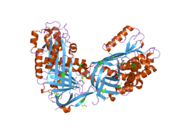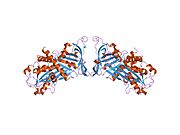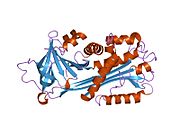
Serpins are a superfamily of proteins with similar structures that were first identified for their protease inhibition activity and are found in all kingdoms of life. The acronym serpin was originally coined because the first serpins to be identified act on chymotrypsin-like serine proteases. They are notable for their unusual mechanism of action, in which they irreversibly inhibit their target protease by undergoing a large conformational change to disrupt the target's active site. This contrasts with the more common competitive mechanism for protease inhibitors that bind to and block access to the protease active site.
A trypsin inhibitor (TI) is a protein and a type of serine protease inhibitor (serpin) that reduces the biological activity of trypsin by controlling the activation and catalytic reactions of proteins. Trypsin is an enzyme involved in the breakdown of many different proteins, primarily as part of digestion in humans and other animals such as monogastrics and young ruminants. Serpins – including trypsin inhibitors – are irreversible and suicide substrate-like inhibitors.
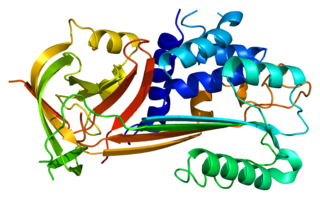
Plasminogen activator inhibitor-2, a serine protease inhibitor of the serpin superfamily, is a coagulation factor that inactivates tissue plasminogen activator and urokinase. It is present in most cells, especially monocytes/macrophages. PAI-2 exists in two forms, a 60-kDa extracellular glycosylated form and a 43-kDa intracellular form.

Alpha 1-antichymotrypsin is an alpha globulin glycoprotein that is a member of the serpin superfamily. In humans, it is encoded by the SERPINA3 gene.

Kallikrein-2 is a protein that in humans is encoded by the KLK2 gene, and is particularly associated with prostatic tissue.

Suppressor of tumorigenicity 14 protein, also known as matriptase, is a protein that in humans is encoded by the ST14 gene. ST14 orthologs have been identified in most mammals for which complete genome data are available.
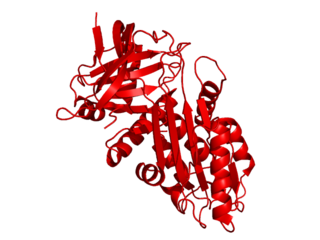
Serpin B3 is a protein that in humans is encoded by the SERPINB3 gene.

Kallikrein-10 is a protein that in humans is encoded by the KLK10 gene.

Serpin B9 is a protein that in humans is encoded by the SERPINB9 gene. PI9 belongs to the large superfamily of serine proteinase inhibitors (serpins), which bind to and inactivate serine proteinases. These interactions are involved in many cellular processes, including coagulation, fibrinolysis, complement fixation, matrix remodeling, and apoptosis .[supplied by OMIM]

Glia-derived nexin is a protein that in humans is encoded by the SERPINE2 gene.

Serpin B4 is a protein that in humans is encoded by the SERPINB4 gene.

Serpin B6 is a protein that in humans is encoded by the SERPINB6 gene.

Large tumor suppressor kinase 1 (LATS1) is an enzyme that in humans is encoded by the LATS1 gene.

Leukocyte elastase inhibitor (LEI) also known as serpin B1 is a protein that in humans is encoded by the SERPINB1 gene. It is a member of the clade B serpins or ov-serpins founded by ovalbumin.

Hepatocyte growth factor activator is a protein that in humans is encoded by the HGFAC gene.

Reversion-inducing-cysteine-rich protein with kazal motifs, also known as RECK, is a human gene, thought to be a metastasis suppressor.

Cystatin-M is a protein that in humans is encoded by the CST6 gene.

Serpin B8 is a protein that in humans is encoded by the SERPINB8 gene.
Myeloid and erythroid nuclear termination stage-specific protein (MENT) is a member of the serpin family of protease inhibitors, and participates in DNA and chromatin condensation. Alongside its ability to condense chromatin, MENT is also an effective inhibitor of the proteases cathepsin K, cathepsin L, and cathepsin V, all of which are cysteine proteases. As such, although MENT is structurally classified as a member of the serpin family, it is functionally termed a "cross-class inhibitor," as it is a cysteine rather than a serine protease inhibitor.
Uterine serpins are members of the A clade of the serine protease inhibitor (serpin) superfamily of proteins and are encoded by the SERPINA14 gene. Uterine serpins are produced by the endometrium of a restricted group of mammals under the influence of progesterone or estrogen. These proteins appear to be inactive protease inhibitors and may function during pregnancy to regulate immune function or participate in transplacental transport.


















